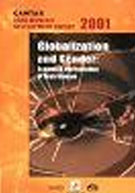Arab women s Development report 2001: Globalization and Gender: Economic Participation of Arab women

Countries, companies, and individuals are struggling not be first in the “race to the bottom” as space and time shrink and borders disappear.
The information age is rapidly transforming the industrial era, which has in turn displaced the agricultural economy. As these changes occur, policy makers in the Arab region have little information about the impact on people – and almost none about the implications for Arab women.
The first CAWTAR Arab Women’s Development Report 2001 has been designed to address this glaring gap. It provides solid analysis and recommendations, in addition to 100 tables and graphs containing crucial data for anyone seeking to understand the overall phenomenon of globalization and its gender dimensions in particular.
The report was put together by a team of experts who worked for nearly 18 months to collect the data and to analyze them.
It is the first one in a series of reports on Arab women’s development that CAWTAR intends to produce annually.
Each report will address one neglected dimension of development.
The Report contains major findings concerning the impact of globalization on Arab women as regards their opportunities for economic participation:
1 .In most Arab states, FDI is not targeting sectors where female labour is likely to grow. For example, the flow of FDI to Saudi Arabia, which is reproduced in Graph 2, went primarily to the petrochemicals sector, where male labour predominates. In Egypt, FDI went mostly to four industries: chemicals, building materials, food processing, and textiles. Women participate only in the last two sectors. In Bahrain, flows went to the services sector, where women tend to be well represented. The bulk of the flows to Morocco and Tunisia have gone to the energy sector; a much smaller share went to textiles and leather, where there is some female labour force participation.
2. There are no far-reaching changes in the overall share of female labour in service sectors linked to global restructuring – such as information and communication technologies, trade and tourism.
3. There is a subtle trend of encouraging Arab women to withdraw from the labour force – including women whose education and skills could contribute significantly to economic and social development. This trend runs counter to the increased feminization of labour brought on by globalization in other parts of the world.
The Report makes several recommendations and also suggests areas for further research. In particular, the Report urges the following:
1. Review social security and tax regulations to ensure that Arab women workers are seen as economically independent individuals rather than depending on male kin.
2. Acknowledge and address Arab women’s unemployment and under-employment, recognizing that women income is crucial both for family survival and development.
3. Pay special attention to equal access for women and men to affordable credit, production-enhancing technology, and market-relevant training skills.
(Publication is in hard copy at CAWTAR)
Return
